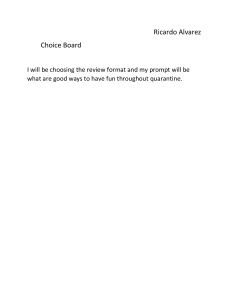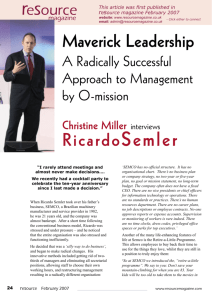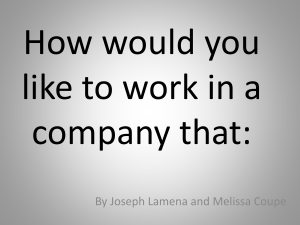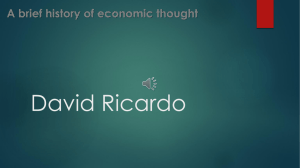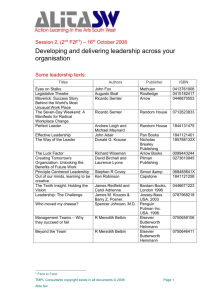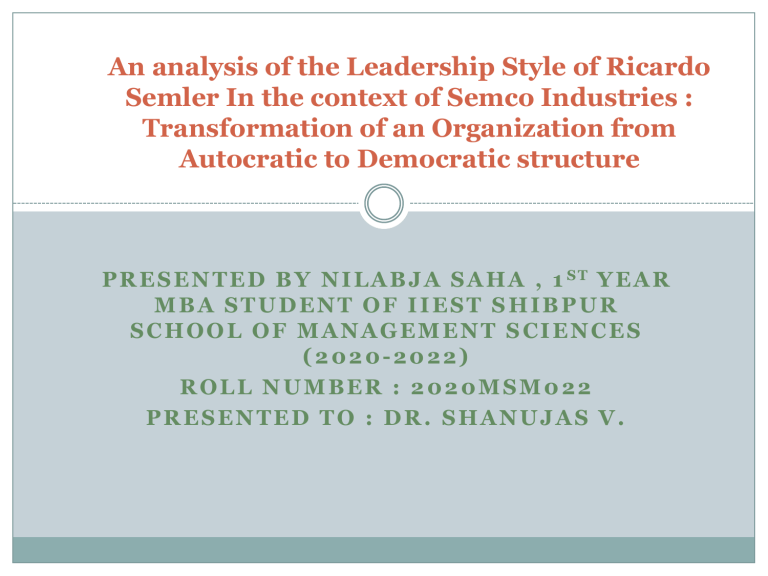
An analysis of the Leadership Style of Ricardo
Semler In the context of Semco Industries :
Transformation of an Organization from
Autocratic to Democratic structure
P R E S E N T E D B Y N I L A B J A S A H A , 1 ST Y E A R
MBA STUDENT OF IIEST SHIBPUR
SCHOOL OF MANAGEMENT SCIENCES
(2020-2022)
ROLL NUMBER : 2020MSM022
PRESENTED TO : DR. SHANUJAS V.
A Close Portrait of Ricardo Semler , The Brazilian Boss , Entrepreneur ,
One who runs his organization in self – serving mode !!!
A Brief History on Ricardo’s Life and Rise
Antonio Curt Semler , Ricardo Semler’s father , an Australian
engineer , left Austria after his studies just before World War II to make
a new life in South America. He took advantage of Brazil’s first
‘economic miracle’ in the 1950s and 60s to build his company, a major
supplier of marine pumps for the shipping industry. But he wanted to
do more. He wanted to build a family business, a lasting legacy.
His young son Ricardo was not, however, a natural successor.
Semco was founded in the 1952 by Antonio Curt Semler.
A Brief History… (Continued …)
Ricardo did not do well in school but he started to show some
entrepreneurial flair in high school by taking the responsibility of
running the school’s snack shop .
After studying law in Brazil’s prestigious law school , Ricardo tried to
put his feet on his father’s shoes .
After the brazilian miracle in 1960-70s (Steep rise in Brazil’s economy)
, which ended in late 70’s and have put a deep economical impact in
Brazil’s Economy specially the shipbuilding industry , Ricardo took
over Semco Industries from his father and proposed that diversification
is the only solution at that time , although he had a strong dissent with
his father on the future line of actions of Semco Industries .
A Brief History… (Continued …)
Ricardo’s father , after realizing that Ricardo and he can
not co-exist in the same organization , simply handed
over the entire operation to Ricardo .
One Friday afternoon in 1980 , Ricardo cleaned house ,
fired 60% of his father’s top executives. He hired his own
people and began modernizing the company, making it
more efficient and productive. For example : Semco ,
persuaded salespeople to fill out customer-visit reports
and keep statistics on orders closed versus quotes offered
. Production schedules were also displayed on boards in
the new planning and control department.
A Brief History… (Continued …)
By 1982 , Ricardo and the other new blood had turned the company
around. They were manufacturing a wider range of products and
secured some major contracts and new acquisitions. They had nearly
doubled the workforce and tripled the number of plants, where they set
about applying the new systems and financial controls .
But things didn’t go as it was intended . In Ricardo’s words “Semco
appeared highly organized and disciplined , but we still could not get
our people to perform as well as we wanted . People were working long
hours and families were complaining. Deliveries were always late .” “I
knew our new tough-minded, statistical approach, along with our
acquisitions and all the new employees, had created a lot of stress” ,
Ricardo admits .
A Brief History… (Continued …)
Once During a visit to a pump factory in the U.S. , Ricardo collapsed on
the factory floor being sick . Also , at the annual corporate retreat ,
someone snuck into the conference room and drew a cartoonish Grim
Reaper on one of the flip charts , holding a scythe and surrounded by
bleeding stick figures . This incidents conveyed the message that
Ricardo’s autocratic leadership style was wreaking havoc on
him , his employees and the company , Semco . Ricardo went to
some doctor(s) and the doctor(s) advised him only : everything about
Ricardo’s life has to be changed .
Then Ricardo went to the Botanique Hotel taking some time off from
his duties from Semco , a luxury eco-resort two hours outside Sao
Paulo , Brazil and Fernanda Semler , Ricardo’s wife and
Ricardo’s brainchild . Ricardo took some rest and relaxation to
relive and rejuvenate in the hotel Botanique .
A Brief History… (Continued …)
The Botanique hotel had no departments and
no fixed positions . All employees were skilled
waiters, many are barmen, all knew how to operate the
high-end cappuccino machine, all made beds fast,
some played tennis, others played the piano and many
were hikers, wildlife monitors or capoeira (Brazilian
martial art) masters.
This permits the hotel to function at 18.5% breakeven,
a level that no hotel has seen (average breakeven in
hotels is 39% at Brazil)
A Brief History… (Continued …)
According to Fernanda , Ricardo’s Wife , the hotel provided a “post-luxury”
experience that includes the best that Brazil has to offer. But Botanique was not only
the most expensive hotel in Brazil, but also the first hotel based on a highly
democratic philosophy where employees make all the hiring decisions
themselves. For those who helped building the hotel, a position was created to
match their talent as long as they were willing to be flexible as well. For example,
Leandro, a capoeira teacher in his free time, helped cleaning during the construction
of the hotel and now organizes capoeira classes for guests. But just like the drivers,
waiters, and the hotel pianist , he also needs to clean the rooms.
Botanique sought to maximize the flexibility and freedom of its employees, giving
them a level of control that encourages them to take initiative and craft their jobs in
a way that best leverages their own individual abilities and interests. Decisionmaking at Botanique was fully democratic and requires the input of all staff
members who, in turn, need to be fully informed about occupancy rates, expenses
and ongoing activities at all times. For example, everyone was involved in
interviewing potential colleagues and bosses and new people cannot join without the
input of all staff members first. Ricardo and Fernanda said that it is precisely
because of these policies that Botanique has been a success story so far, having won
numerous industry awards in its short time in operation.
A Brief History… (Continued …)
However, Ricardo didn’t have the luxury of starting from scratch when he
wanted to transform the culture and management practices at Semco. But he
knew things had to change. His employees were stressed and unhappy, and his
own health problems were a testament to the deleterious effects of such
management practices on both followers and leaders.
Then , Ricardo put the principles and working style that was prevalent at the
Botanique hotel into his organization , Semco , in various phases . He turned
Semco from an autocratic organization to a democratic one where employees
are free to take key decisions like hiring decisions , and it is the company that
runs itself .
Semco’s Radical Make Over : 1984
Ricardo started leaving the office at 19:00 and stopped
working weekends . He stopped wearing a watch and
started spending time outside work .
To help him manage the changes he wanted at Semco,
Ricardo teamed up with a new human resources director,
Clovis Bojikian, a former school teacher .
Semco’s Radical Make Over … (Continued …)
Dress code was abolished . Surveillance was also made not very tight .
Things like expense reports were then eliminated – employees would
monitor their own spending when away from the office. And a nonterritorial, open office plan was created with plants and flowers
separating communal desk spaces that were used on a first-come-firstserved basis.
Semco’s Radical Make Over … (Continued …)
Flexible working hours were introduced on the manufacturing shop
floor so that employees could work the hours that were most
convenient for them.
In the mid-1980s, Semco manager João Vendramin convinced Semler
to create a lattice organization. Under this program, self-managed
groups of six to ten manufacturing employees were placed in charge of
all aspects of production. To promote a sense of true ownership of the
process, the groups were charged with setting their own budgets and
production goals. Tying salaries to monthly budget and production
performance aligned employee and organizational goals. With the
implementation of the lattice, unit production costs fell dramatically
while employee productivity soared.
Semco’s Radical Make Over … (Continued …)
Ricardo moved on from dress codes and expense accounts to bigger
matters. When a new factory was needed, a search committee of workers
was created to research and make the decisions themselves. Workers
were subsequently given control over how the plant itself was set up and
run. Perhaps most interesting was the employee-suggested system of
“manufacturing cells”: small clusters of workers, each responsible for
creating batches of the entire product. Although each team would be
entirely responsible for product quality, they would also have the
satisfaction of learning how to operate all the machines involved and of
completing a task from start to finish. As the accountability of the teams
increased, so the need for quality control decreased – and whole
departments were abolished.
The size of Human Resources department was reduced from 90 people
to two. In its place, a new worker-led hiring system sprang up. Workers
started to recruit new members for their own teams – and fire those who
did not measure up. And a new job rotation plan meant that employees
were encouraged and even expected to change departments regularly.
Semco’s Radical Make Over … (Continued …)
Semco then implemented a system whereby subordinates played a key role in directly
evaluating their bosses. Every employee completed the form twice a year with anonymity
guaranteed. However, the manager’s overall score (average 80-85; 70 minimum to
remain in good standing) was posted for the entire company to see, putting those with
low scores (less than 70) “under intense pressure to change”, as Ricardo wanted . The
system not only helped mangers improve their skill and increased communication; it
helped insure bad managers could not hide for long.
Employees were asked to consider their length of service, level of decision making, and
time spent with customers as they decided on a figure to request for their remuneration .
By 1989, Semco had one of the highest growth rates in the country. It won a national
award for labor relations. Sales had risen from around $4 million, when Ricardo took
over, to $35 million. Where once it was a company with only one factory and 100
employees, it now had six factories and 830 employees.
Lewin's 3-Stage Model of Change in Transforming Semco :
Some Words
The Final Transformation of Semco : The 1990s
In 1990, Brazil’s economy crashed. Industrial output fell by 9% and GDP was
back to what it had been in the 1970s. By 1992 there were nearly 1.5 million
unemployed in São Paulo alone. Between 1989 and 1991, Semco’s sales fell by
40%. Layoffs seemed as inevitable but some other option instead of layoff has
been tried . The workers, took a 30% pay cut and gave up most of their benefits.
The managers, for their part, agreed to an even greater pay cut.
By the end of third month, salaries had been restored to their old levels. Profit
sharing also compensated for the reduced salaries .
In an economic crisis that saw an average of 800 Brazilian companies going
broke every month, Semco survived and managed to break even in the very
worst years – but it was almost unrecognizable as the company founded by
Antonio Semler. Productivity had soared to six and a half times the level of
1980 by 1994 and was four times the national average. Sales had recovered to
around $20 million.
Analysis on the Style of Ricardo
Semler’s Leadership Style
Ricardo Semler is a successful transformational leader, he transformed Semco
company into a modernize organization. Semler was in an autocratic leadership style in the
early stage of 1982, which possessed power of authority and high management control over
his employees. They needed to work long hour, dress formally and constantly monitor under
surveillance in order to keep up with the production schedule. However, Semler adopted to
democratic leadership style as he has health problem from the stress originated from long
hours of activity in office and found out his employees were equally unhappy with the
organizational culture in later year of 1984.
Semler has demonstrated the characteristics as below :
Charismatic vision
Empathy communication
Confident and trust
Innovation and creativity
Kaizen
Individual output increase
The Results of Transformational
Leadership
Style of Ricardo’s Leadership from McGregor’s Theory :
Theory X and Theory Y
Explanation of Ricardo’s Leadership Style using Blake and
Mouton’s Managerial Grid : Some Words
Conclusion
In Semco , Anyone, including lower level workers, is welcome to attend almost any meeting, read
any reports and memos. Everyone is allowed to attend the budget meetings where targets and
quotas are decided. Two spots are reserved for anyone to sign up and attend board meetings but
nobody is obligated to attend meetings either, and people come and go as they like . That proves
how much Semco promotes individual freedom at work .
Ricardo also tried to use the “Semco Philosophy” in other sections of human development in the
society . With some help from the Gates Foundation and the Harvard Graduate School of
Education, he set up three schools in Brazil, the Lumiar schools, where the underlying
pedagogical philosophy was to make students rather than teachers the center of the learning
experience. In Ricardo’s explanation - Children choose their own subjects so that they are more
motivated to acquire relevant language, math, and social skills. But the focus on the individual also
takes place in the context of joint development. They vote collectively on their group activities and
the majority decides.
In this system, the teacher is replaced by a “Tutor” and multiple “Masters.” The Tutor is
responsible for mapping out the future of each child’s learning, with episodic consultation of
parents. The Master is someone who must possess two qualities: expertise in some subject and
passion. The expertise of these Masters can be math, even though the Master is trained as a
violinist, for example. The subjects are grouped under current interests of the students.
A famous quote from Ricardo Semler’s Mind !!
Key Facts and Figures of Semco’s Success
As of 2003, Semco had annual revenue of $212 million, up from $4 million in
1982 and $35 million in 1994, with an annual growth rate of up to 40 percent a
year. It employed 3,000 workers in 2003, as opposed to 90 in 1982. The
company's units include:
The industrial machinery unit, which now manufactures mixing equipment as
opposed to pumps
Sembobac, a partnership with Baltimore Air Cooler making cooling towers
Cushman and Wakefield Semco, a partnership with Rockefeller property
company Cushman and Wakefield managing properties in Brazil and Latin
America
Semco Johnson Controls, a partnership with Johnson Controls, managing large
scale facilities such as airports and hospitals
ERM, a partnership with Environmental Resources Management, one of the
world's leading environmental consultants
Semco Ventures, offering high technology and Internet services
SemcoHR, a human resources management firm
Semco-RGIS, an inventory control firm
Sources :
1) Ricardo Semler: A Revolutionary Model of
Leadership : INSEAD Case Study (Primary
Source)
2) How to run a company with (almost) no rules :
https://www.ted.com/talks/ricardo_semler_how
_to_run_a_company_with_almost_no_rules
3) Ricardo Semler and Semco SA : A Case Study –
The American Graduate School of International
Business
Feedback
Please feel free to share your feedback on this
presentation .
Thank you all and The End !!

